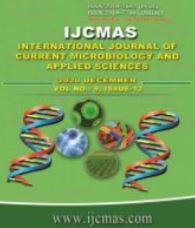


 National Academy of Agricultural Sciences (NAAS)
National Academy of Agricultural Sciences (NAAS)

|
PRINT ISSN : 2319-7692
Online ISSN : 2319-7706 Issues : 12 per year Publisher : Excellent Publishers Email : editorijcmas@gmail.com / submit@ijcmas.com Editor-in-chief: Dr.M.Prakash Index Copernicus ICV 2018: 95.39 NAAS RATING 2020: 5.38 |
The present study emphasizes on profile of macro and micronutrients and fungal flora of wheat, maize and Sorghum rhizosphere soils at sowing, flowering and harvesting stages of crops from Baramati area of Pune district of Maharashtra. From the studied fields total 14 fungal genera and 17 species belonging to fungal group Mastigomycotina (03), Zygomycotina (02), Ascomycotina (01), Basidiomycotina (01) and Deuteromycotina (07) were reported. The wheat field soils of Sangavi, Pandare and Tawadi area showed deficiency of nitrogen and phosphorus, very high amount of potassium and calcium, sufficient amount of magnesium, sulphur at lowest amount, the micronutrients iron, manganese, zinc and copper reported at stress amount compared to standard values. The fungi isolated from wheat fields were majority saprophytic and Alternaria and Fusarium reported as pathogenic. Macro and micronutrients profile of maize was studied from Deulgaon Rasal, Sangavi and Nimbodi fields. Like wheat fields, maize field soils also showed deficiency values of nitrogen, phosphorous and sulphur. The amount of potassium, calcium and magnesium was very high, the concentration of iron, manganese, zinc and copper were extremely less compared with standard values. The parasitic fungi Phytophthora, Helminthosporium, Fusarium and Alternaria were most frequently reported from all studied maize fields. The Sorghum field soils studied from Malad, Deulgaon Rasal and Jalgaon reported the deficiency level of nitrogen and phosphorous, the quantity of potassium was at very high level, the amount of calcium and magnesium was adequate and the concentration of sulphur, iron, manganese, zinc and copper were at declined level. Almost saprophytic fungi Penicillium, Aspergillus and Mucor and pathogenic fungi Helminthosporium and Fusarium were reported frequently from rhizosphere soils of Sorghum.
 |
 |
 |
 |
 |